|
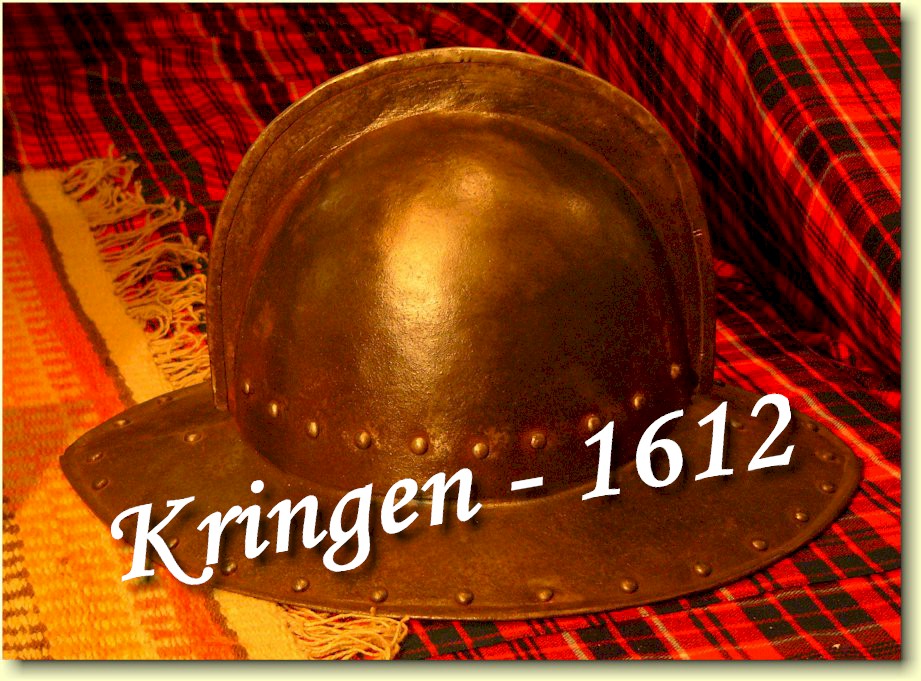
|
| |
 |
Translation
into English by
Norman Henderson |
 |
|
| |
|
|
|
|
| |
Web:
Geir Neverdal (lektor/cand.philol) - Sel Historielag |
|
| |
|
|
|
|
|
|
|
|
|
|
Objects associated with
The Scottish March
Many of these objects can be seen in
The Scottish March Collection at the Sinclair Inn at
Kvam.
|
| |
|
|
|
Background - The
Battle - Myths?
- Significance - Objects - Literature - Scotland
-
Programme2012 |
| |
|
|
| |
|
|
| |
When Nicolai Christian Lassen wrote his Diary
from his journey through the valley in 1777 he
pointed out that
“There are many Swords and Flints (Flintlock
rifles) which were captured in the Victory
the Inhabitants won for themselves in
Kringen against the Scots Anno 1612 under
Farmer Sheriff Lars Haje’s Leadership”
(Nicolai Christian Lassen p.7)
|
|
| |
|
|
| |
Contents of
this page: |
|
| |
|
|
|
|
|
| |
|
Weapons etc. associated with The Scottish March
Discoveries in the Kringen area in later times?
Jewellery and brooches/pins
National costume from 1912
Paintings associated with The
Scottish March |
|
Postcards, also from the 1912
Anniversary
Music associated with Pillarguri and
Sinclair
Various items associated with
Pillarguri and The Scottish March
|
|
| |
|
|
|
| |
|
|
| |
|
|
| |
Weapons etc. associated with The Scottish March and
Kringen |
|
| |
|
|
| |
|
|
| |
Wheel-lock rifle
Battle axe
Powder horn
Box/chest |
|
|
|
|
| |
|
|
| |
|
|
| |
| |
Wheel-lock
rifle from The Scottish March: |
|
|
|
|
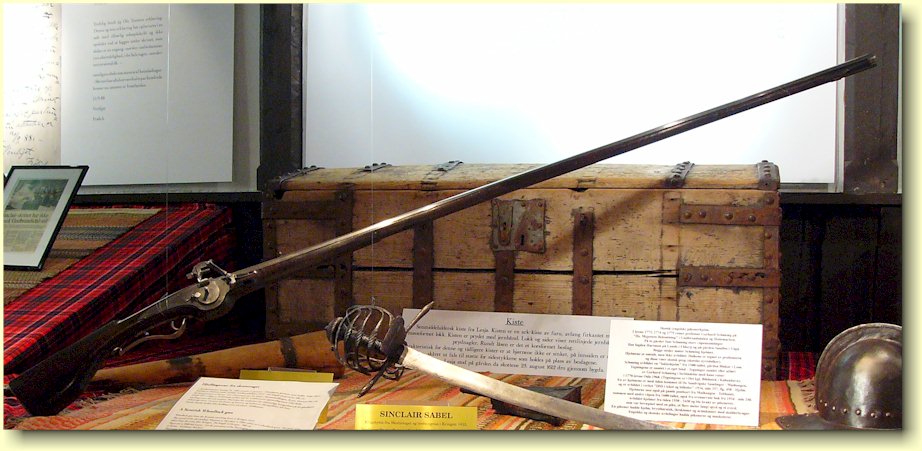 |
| |
|
|
|
| |
“5 rifles
are mentioned in the Artillery museum’s catalogue from
1904. “Smoothbore rifles with wheel-locks, long barrels.
Left behind by the Scots during their raid in
Gudbrandsdalen in 1612”.
Complete length of the rifle: 205cm. (80,7 inches)
Five rifles are preserved - four are owned by the
Ministry of Defence, the fifth is in the The Scottish
March Collection, Kvam.
This rifle was at one time given to a previous, though
now long deceased, Head of the Air Force:
Lieutenant General Odd Bull”
(The Scottish March Collection, Kvam.) |
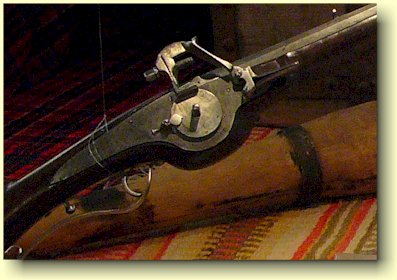 |
|
| |
|
|
| |
|
|
| |
|
|
| |
Powder bottle for musketeers
(The
Scottish March Collection, Kvam.) |
Scottish
type - St. Andrew’s cross |
|
|
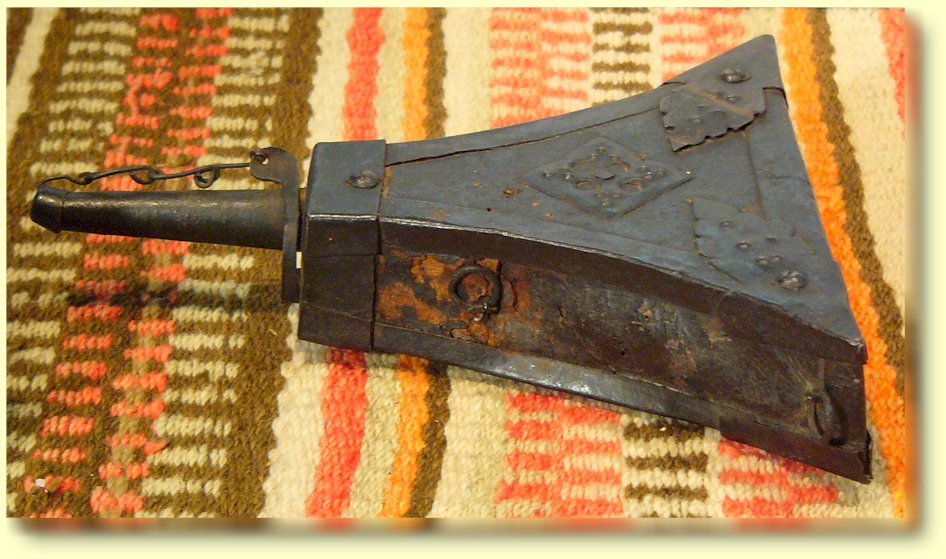 |
| |
|
|
| |
|
|
| |
|
|
|
| |
Sabre
(The
Scottish March Collection, Kvam.) |
 |
|
| |
|
|
|
| |
|
|
| |
|
|
| |
|
|
| |
|
|
|
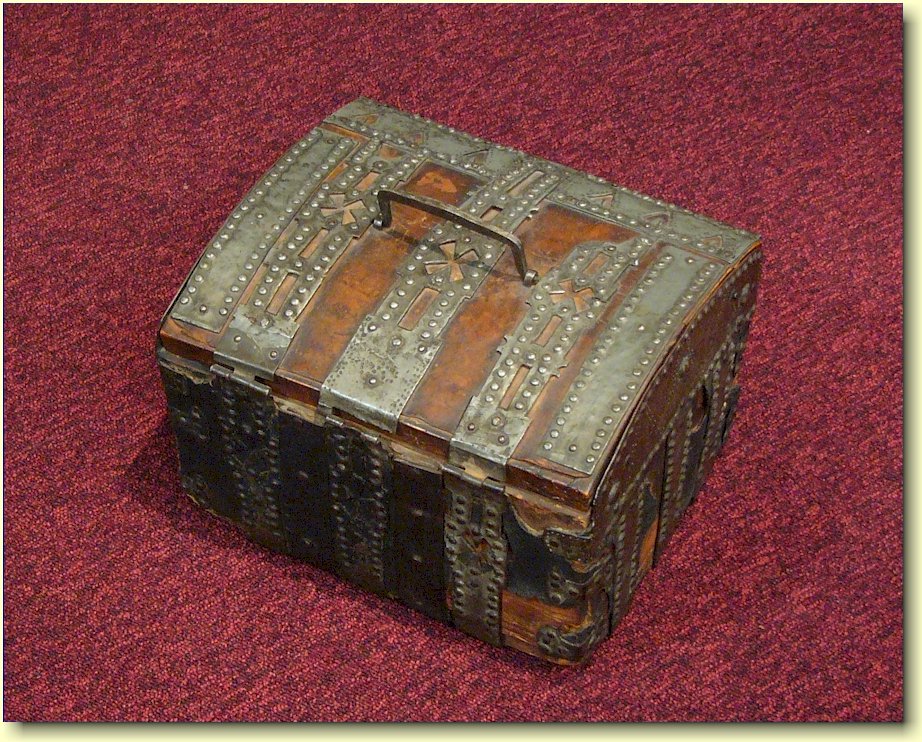 |
| |
(Skottetogsamlingen i Kvam) |
|
|
| |
|
|
|
| |
|
|
| |
|
|
|
| |
Powder
horn
“Scottish
(English) powder horn from the 1600s.
The horn is marked with simple engravings,
amongst others the Tudor rose (the English rose)”.
(The Scottish March Collection, Kvam.)
|
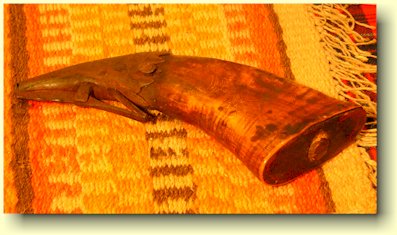 |
|
| |
|
|
|
| |
|
|
| |
|
|
| |
|
|
|
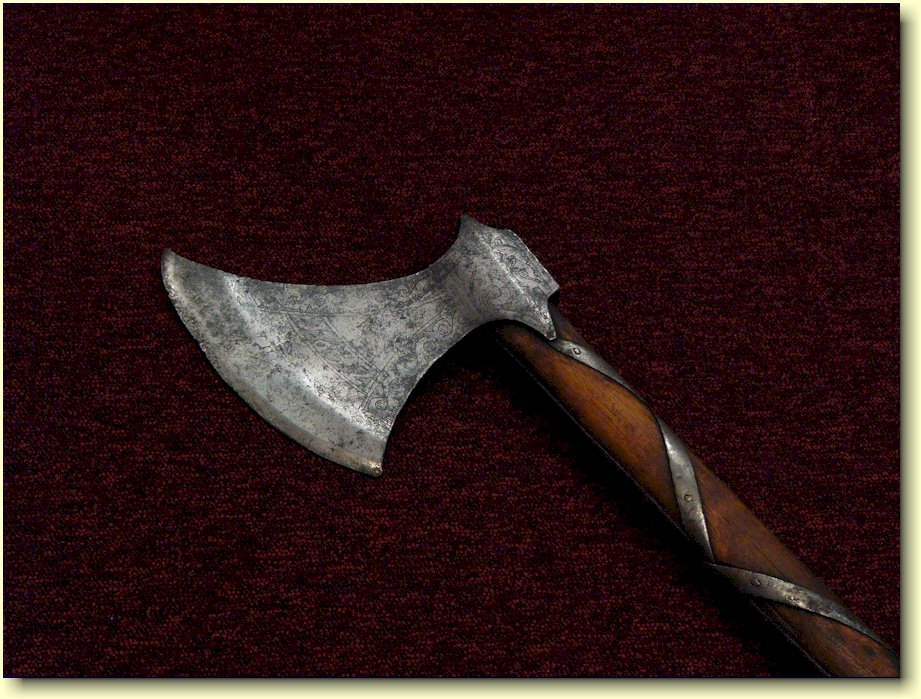 |
| |
Battle
axe from 1550
Today this
type of axe is employed as the Coat of Arms of Telemark
Fylke.
(The Scottish March Collection, Kvam.)
|
|
| |
|
|
| |
|
|
|
|
|
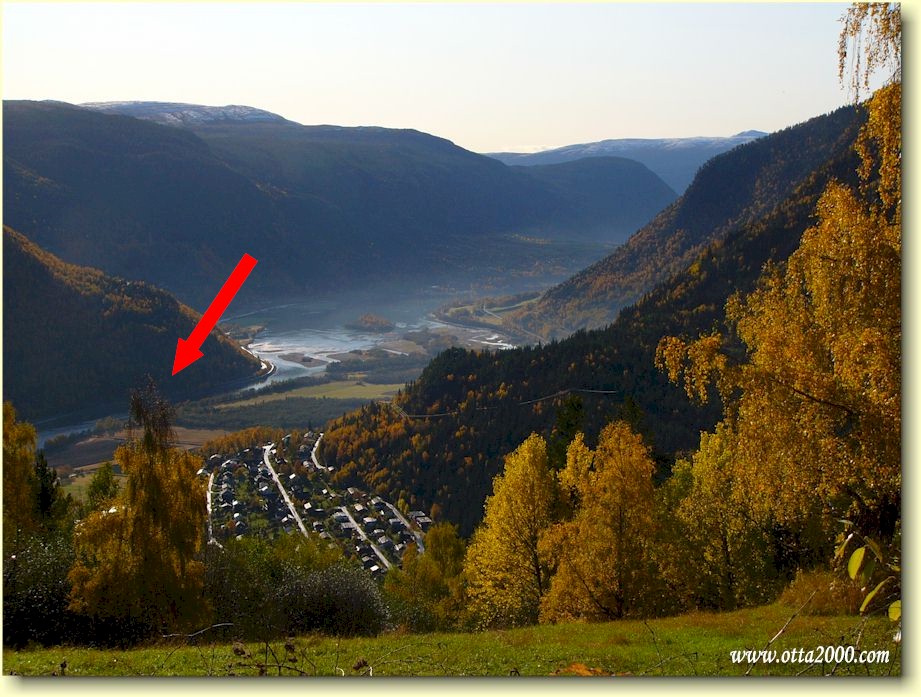 |
| |
|
|
| |
|
|
| |
|
|
| |
Discoveries
in the Kringen area in later times?
Angell tells
us that when the road through Kringen was to be rerouted
in 1854/55, human remains and bones were found. It would
appear that the fiercest fighting took place in the
Northern part of Kringen, where most of the remains were
found, while fewer discoveries were made the further
South one went.
(Angell p.
38).
|
|
| |
There can
however, be several explanations for this. The old
road/track lies somewhat higher up than the new one in
the Southern part of Kringen and consequently was
undisturbed by the road building - the bare rock is
exposed here - and there is hardly enough earth to cover
any remains. It is also possible that the Storofsen
landslide in 1789 scraped away some of the earth which
might otherwise have covered the rock there. |
The Big Flood "Storofsen" took place 20th - 24th
of July 1789. The lake Mjøsa rose to 10 meters
above normal level.
63 people were killed and more than 3000 houses
were destroyed.
(Store norske
leksikon)
|
|
| |
|
|
| |
|
|
| |
Jewellery
and brooches associated with The Scottish March and
Kringen |
|
| |
|
|
| |
|
|
| |
Brooch
from the 1930s or 40s (Sigrid Undset?)
|
|
| |
Historical note
Brooches of this type were produced from the end of the
1800s, and are still made today. It was during the
period between the two World Wars that these brooches
were most popular.
Merete Frisenberg Sundgård remembers that this type of
box was in use by Frisenberg in the 1950s.
Inscription:
PILLARGURI GIVES THE DALESMEN THE SIGNAL ABOUT SINCLAIRS
ARRIVAL AT KRINGEN 1612.
GOLDSMITH/J. Frisenberg/ LILLEHAMMER
Donation to the museum:
Bjerkebæk was handed over to Maihaugen 1998 -
1998
Ownership: 1930 - 1949 Dates uncertain
Ownership: 1949 - 1996
Place of use, certain: Lillehammer, Bjerkebæk
Ownership: 1996 - 1998
Production; 1900 - 1960 Dates uncertain
Measurements:
Diameter Brooch: 5.0 cm.
Material: Jewellers’ Silver- Stamped - 830S
Classification: Jewellery (OU 301) |
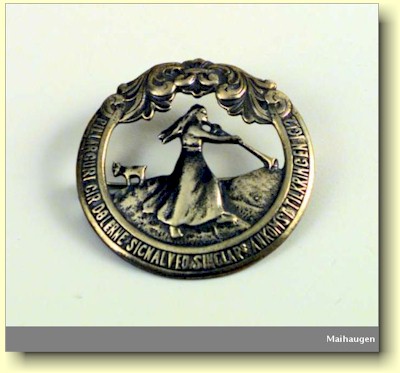
Jewellery
© Maihaugen - 2010, UB - 00609
Designation
Jewellery (principal/overall/general designation)
Breast pin (precise designation)
Brooch (precise designation)
Description
Breast pin or brooch in silver with Pillarguri
motif.
The pin lies in a box from Goldsmith J. Frisenberg.
The box is light blue.
Information and photograph obtained from
Maihaugen.
|
|
| |
|
|
|
| |
|
|
| |
|
|
|
| |
An old
pin
(We will be very grateful for any information
regarding who produced this - and when).
Thanks go to Gunnar Sandbo who owns the pin.
Gunnar Sandbo, Kjell Sandum and Stian Høglien play a
central role in collecting old postcards associated with
Kringen and The Scottish March. They are preparing a
sizeable exhibition of these in connection with the
Anniversary in 2012.
|
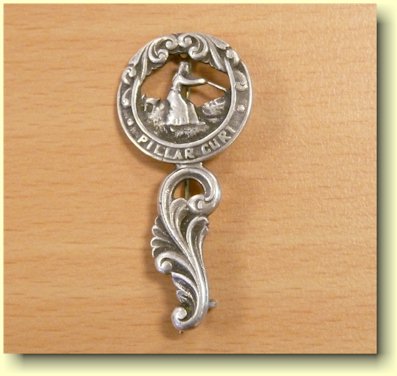 |
|
| |
|
|
|
| |
|
|
| |
|
|
|
| |
An old
brooch
(Thanks go to John Monn for the loan of the brooch)
|
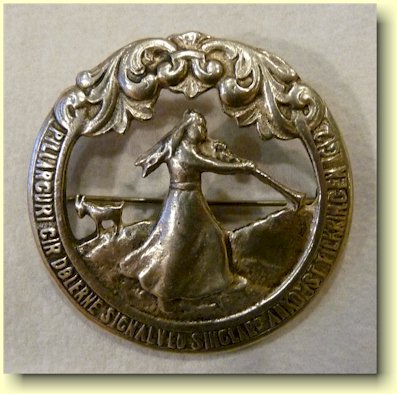 |
|
| |
|
|
| |
|
|
| |
A pin
from 1912
(Thanks go to John Monn for acquiring this) |
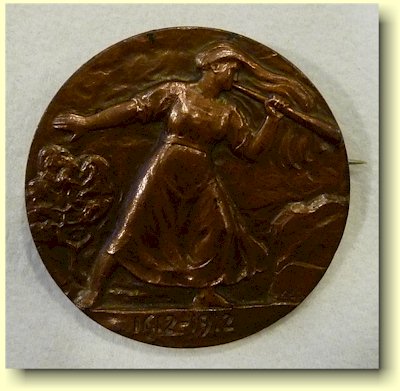 |
|
| |
|
|
| |
|
|
| |
|
|
|
| |
Brooch
A similar design is sold by “Per Bjørvik
Souvenir Production” - oxidised brooch,
59 mm.
Source |
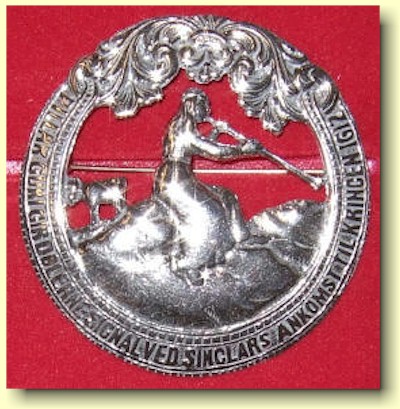
(Thanks go to
Per Bjørvik for the loan of the photograph) |
|
| |
|
|
| |
|
|
| |
Old
brooch from Sel
(Thanks go to Palmar Ruste for the loan of the
photograph) |
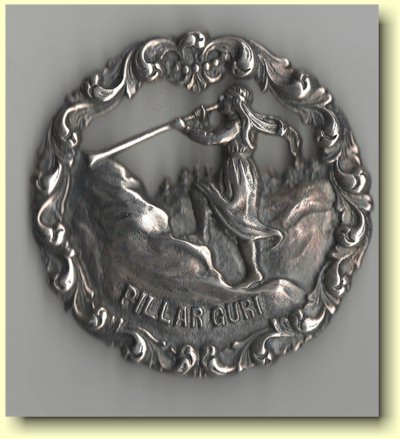 |
|
| |
|
|
| |
|
|
| |
Pillarguri pin 1 - ca. 25 mm wide
- from Sel
Christening gift from 1969
(Thanks go to Palmar Ruste for the loan of the
photograph) |
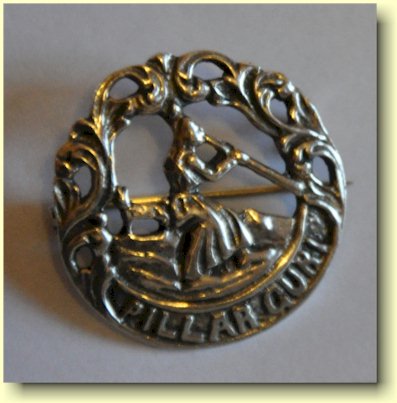 |
|
| |
|
|
| |
|
|
| |
Pillarguri pin 2 - ca. 35 mm wide - from Sel
Christening gift from 1990
(Thanks go to Palmar Ruste for the loan of the
photograph)
|
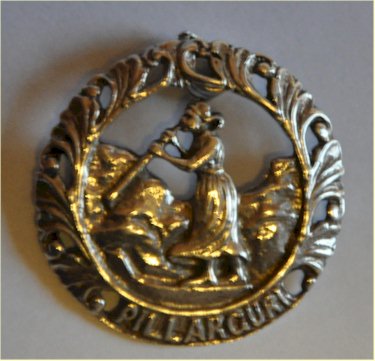 |
|
| |
|
|
| |
|
|
| |
|
|
|
| |
Pillarguri pin - Christening gift
“Has been owned by the family for quite some time”
Source |

Photo is coming |
|
| |
|
|
|
| |
|
|
| |
Anniversary pin
Gudbrandsdalen Society in the USA 1909 - 2009
Read more |
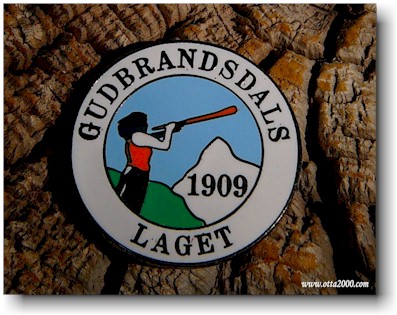 |
|
| |
|
|
|
| |
|
|
| |
Pillarguriskrin
Maling på glass, tre og terracotta
Pillarguri jewel box
Painted on glass, wood and tile
Source |

Photo is coming |
|
| |
|
|
|
| |
Pillarguri pin - Sel kommune |
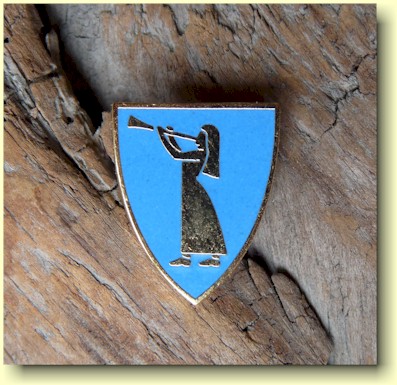 |
|
|
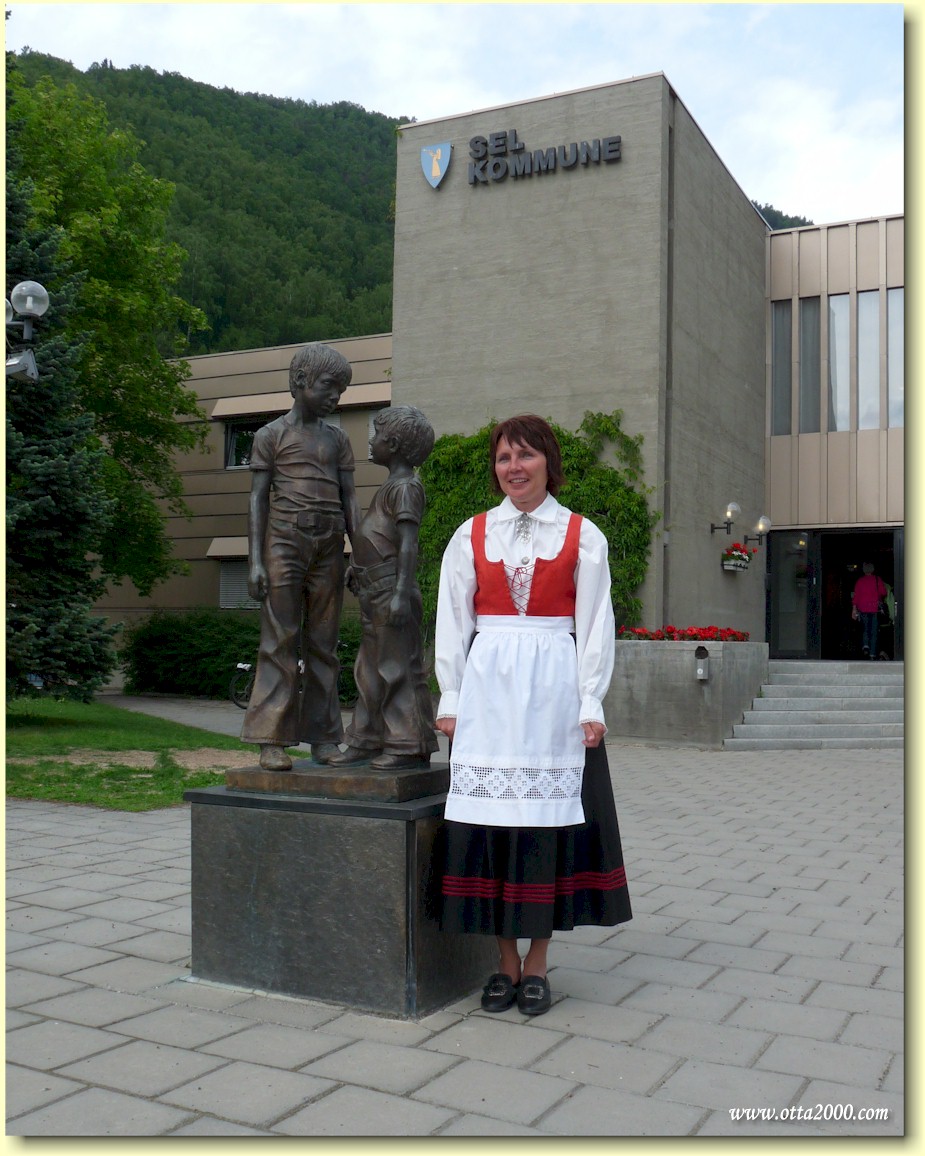 |
| |
This example
of local National costume is approx. 100 years old and
was made specially for the 300th. Anniversary at Kringen
in 1912. It was donated to Sel Kommune by Kristine and
Lars Grøneng - and will be an important item in the
exhibition in 2012.
(Thanks go
to Eva Martinsen, Cultural Secretary in Sel Kommune, who
stepped in at short notice as model for this
photograph). |
|
| |
|
|
| |
|
|
| |
Paintings |
|
|
| |
|
|
| |
|
|
|
| |
|
|
| |
|
|
|
| |
The “Bird Room” in the Royal Palace in Oslo |
|
|
| |
|
|
|
| |
The “Bird
Room” is one of the most well-known rooms in the Palace,
not only because of the decoration but also because of
its function as a waiting room for those seeking an
audience. The room is also used for official photography
of the Royal family.
|
|
| |
In
connection with the planning of the room the architect,
Linstow, wrote:
“...I suggest therefore that
the Room be decorated on the Walls with Landscapes,
depicting Norwegian Scenes”
The
decoration of the “Bird Room” was carried out by
Johannes Flintoe
in
1843
(i.e. during the period of union with Sweden). The
subjects bear the stamp of national romanticism which
were prevalent at the time and mirror a growing national
self-awareness and increased interest in Norwegian
nature and history.
The paintings on the walls give the impression that one
is standing in an open arbour looking out at the
Norwegian landscape. Through the trelliswork, which is
entwined with hops, there is a view of the country’s
most well-known areas of natural beauty: Gaustadtoppen,
Vøringsfossen, Vedalsfossen, Jutulen,
Kringen,
Myrhorn, Filefjell, Drivdalen, Vindhella and Feigum.
Information and photograph from the
Royal Family’s website.
|
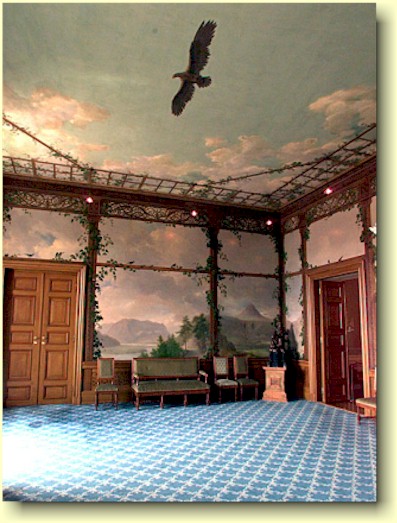 |
|
| |
|
|
| |
|
|
|
| |
The
Garden Room at Frydenhaug near Drammen - inspired by the
“Bird Room” in the Royal Palace in Oslo |
|
| |
|
|
|
| |
A few years
later, between 1846 and 1848, timber merchant and ship
owner Nils Kjær built a main building (living
accommodation on the farm) in classic style, recounts
Arnfinn Engen in the article about Halldor Hjerleid.
(Yearbook for Gudbrandsdalen 2001 pp.55-59)
The decor is designed in such a way that the impression
is that, from inside the room, it appears that one is
outside - looking at three different landscapes:
Vestfjorddalen with Gaustatoppen in Telemark,
Kringen
with the Sinclair Monument in Sel
and a wide
panorama showing Romsdalen with Trolltindene and
Romsdalshorn. The paintings are signed “H. Hjerleid
1848”.
Hjerleid was the founder of the Hjerleid Domestic Arts
and Crafts School at Dovre. He worked also as a
journeyman on the decoration of the Palace in Oslo
before he, in 1847, became a Master painter and started
his own company. So he was very familiar with the “Bird
Room”.
(Yearbook
for Gudbrandsdalen 2001 pp.55-59). |
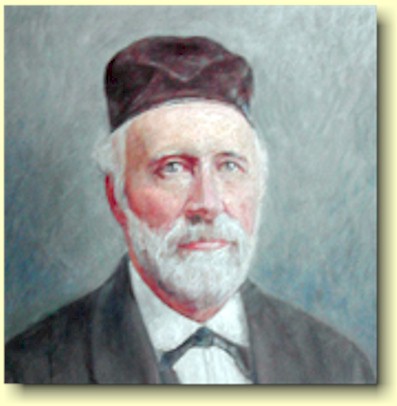
Halldor Hjerleid (1821-1888)
|
|
| |
|
|
| |
Frydenhaug
farm was lived in until 1947, but is today run as a
school for handicapped children. |
|
| |
|
|
| |
|
|
|
| |
The painted glass panel from Valle in Vågå |
|
|
| |
|
|
|
| |
According to
tradition this was made by a Scot whose life Ingebret
Valde saved at Kvam, the day after the battle at
Kringen. (Read more about this here
in Norwegian).
“The photo....shows the 10.5 x 12.5 cm. painted
glass panel inset in a window. The back side of the
panel faces out to the street and is of unbreakable,
rough glass. The decoration.... is an angel
supporting a shield with a symbol on it. Above there
is a near semi-circular 11 x 5,5 cm glass pane
showing a woman’s head surrounded by flowers and
fruit. (Teigum 2, p.116)
(Photo: Ivar Teigum)
This stained glass window from Valle in Vågå is to be
found today in St. Edmund’s Church in Oslo. It was moved
there in the late 1800s.
(Teigum 2
p.116). |
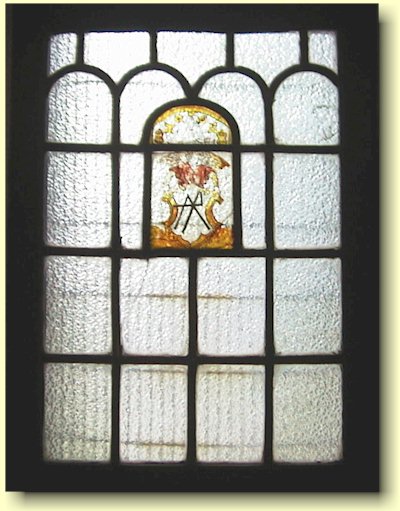 |
|
| |
|
|
| |
| |
|
|
| |
Postcards |
|
|
| |
|
|
| |
|
|
|
| |
|
|
| |
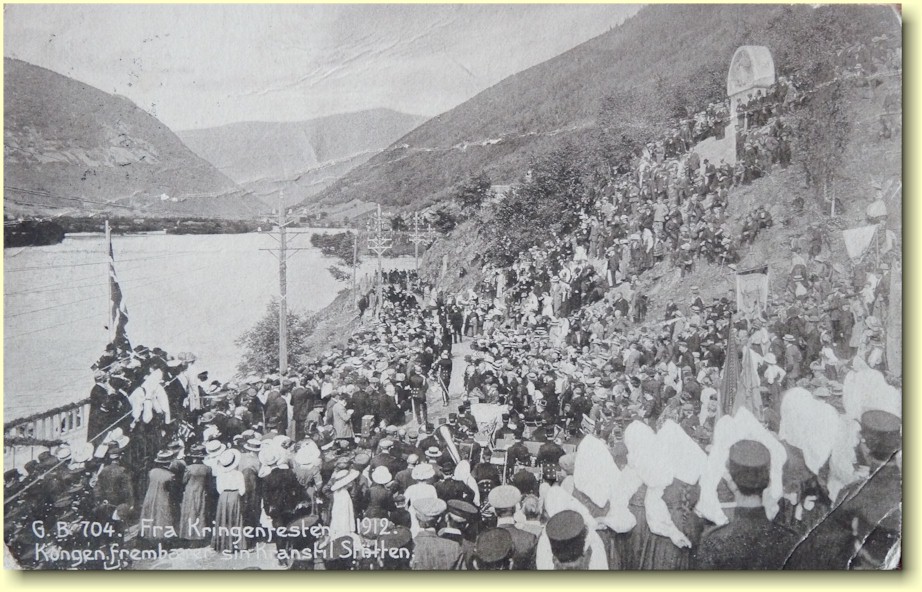 |
| |
Kringen 26th. August 1912 - King Haakon unveils the new
Kringen Monument created by Kristen Holbø |
|
| |
|
|
| |
On the 30th.
December 1915 Erik at Otta sent this card - with good
New Year’s wishes to Kai at the “High School at Aas”.
(The postcard is the property of Jon Selfors) |
|
| |
| |
|
|
| |
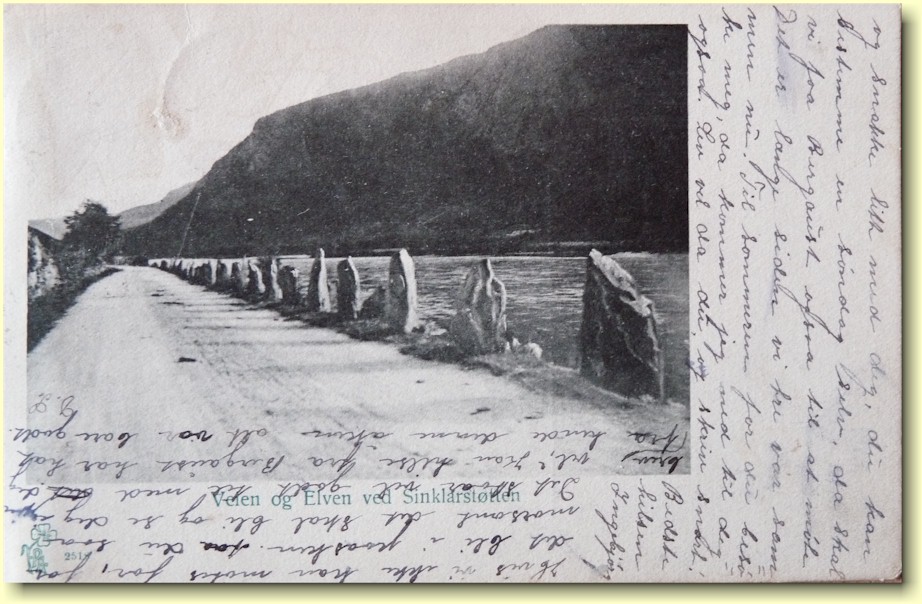 |
| |
The
road and river at the location of the old Kringen
Monument (from 1826/27) |
|
| |
|
|
| |
The picture
was taken
before
1911 - when the card was stamped by Hamar and Gjøvik
Post Offices. It was sent from Ingeborg to Hilda (both
seem to be employed at dairies). The text tells about
the production of Gauda cheese and visit of the master
cheese maker - and expresses the hope that they will see
each other again soon.
(The postcard is the property of Jon Selfors) |
|
| |
|
|
| |
|
|
| |
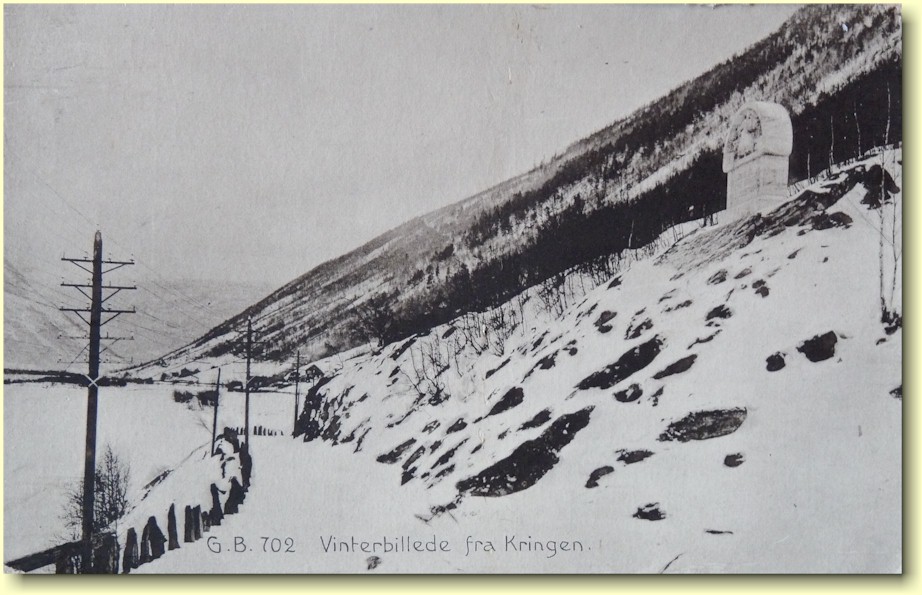 |
| |
Winter
photograph from Kringen |
|
| |
|
|
| |
The
photograph was taken in 1912 or a little later.
There is no text on the back of this card.
(The postcard is the property of Jon Selfors) |
|
| |
|
|
| |
|
|
| |
|
|
| |
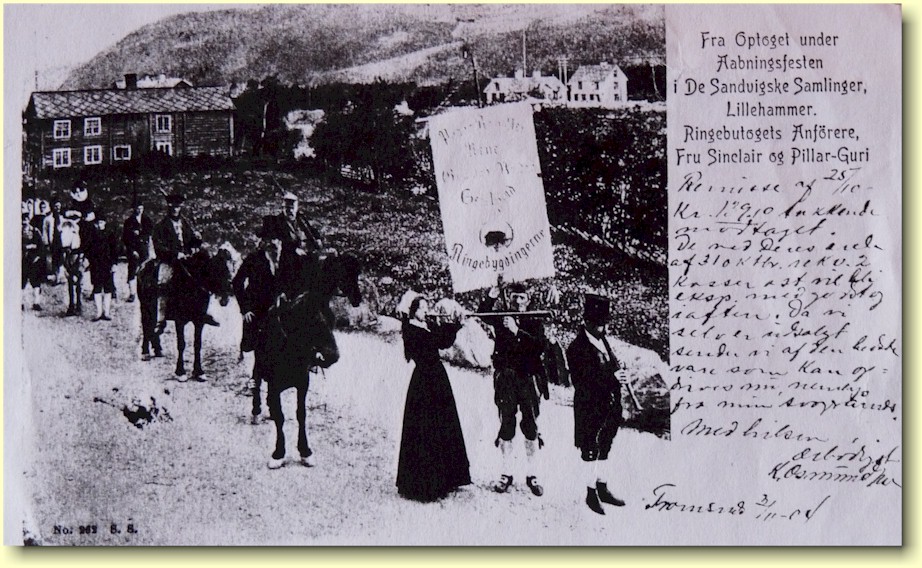 |
| |
From
the procession in 1904 at the opening festivities of De
Sandvigske Samlinger (Maihaugen),
Lillehammer |
|
| |
|
|
| |
The
photograph shows the leader of the Ringebu procession,
Mrs. Sinclair and Pillar-Guri.
The text on the card refers to a delivery of cheese from
Tromsnes and information about payment.
(The postcard is the property of Jon Selfors) |
|
| |
|
|
| |
|
|
| |
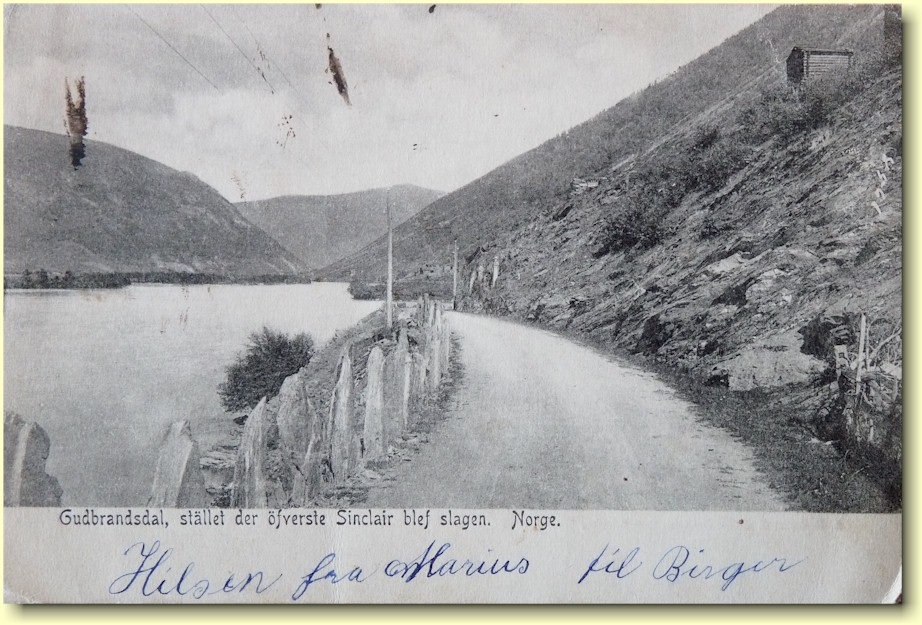 |
| |
Swedish postcard (Malmø) from Kringen. This photograph
is probably older than 1912. |
|
| |
|
|
| |
“Gudbrandsdalen, the place where Colonel Sinclair was
beaten”
To the right at the “end” of the road, the old Sinclair
Monument can just be seen.
This card carries a greeting from Marius to Birger in
Weyburn in Canada.
(The postcard is the property of Jon Selfors) |
|
| |
|
|
| |
|
|
| |
Music |
|
|
| |
|
|
| |
|
|
|
| |
|
|
| |
Folque |
|
| |
|
|
| |
Lisa
Helljesen: song; Jørn Jensen: song/guitar/dulcimer;
Trond Villa: fiddle; Morten Bing:
mandolin/bouzouki/guitar; Eilif Amundsen: banjo/guitar;
Trond Øverland: bass.
Producer: Øystein Sunde
|
|
| |
01 Skøn
Jomfru (Beautiful Virgin)
02 Ravnen (The Raven)
03 Springar (A folk dance)
04 Sjugur og trollbrura (Sjugur and the troll bride)
05 Nissedans (Nisse dance)
06 Harpa (The Harp)
07
Sinclairvisa (The Sinclair Ballad)
08 Reinlender (A folk dance)
09 Allison Gross
10 Steffa går til Seljord (Steffa walks to Seljord)
11 Reven og bjørnen (The Fox and the bear)
12 Heimatlåta (Homeward melody)
Source |
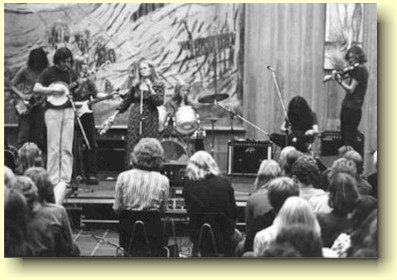
1975 at the Munch Museum:
Trond, Eilif, Lars, Morten, Morten and Trond.
(With thanks to
Folquefor the loan
of the photograph.)
|
|
| |
| |
|
|
|
| |
|
|
| |
The
Sinclair Ballad recorded on the Faroe Islands |
|
| |
|
|
| |
|
|
| |
(Information to come later) |
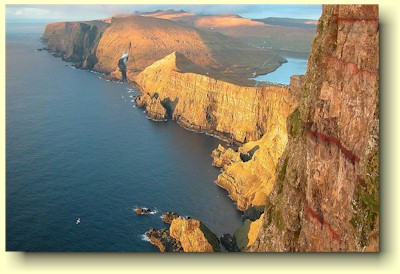
The Faroe Islands
(Wikipedia) |
|
| |
|
|
|
| |
|
|
| |
|
|
| |
Sataøen, S
PRILLARGURI
- Springar from Hallingdal COLUMBIA
GN 84 1935 |
|
| |
|
|
| |
|
|
| |
|
|
| |
Prillarguritrall
(Prillarguri
melody - see page 148 on the link page)
“This
melody tells, stage by stage, what happened during the
battle at Kringen. Magny de la Nuez heard part of this
played by a Scottish bagpipe band when she lived in
Canada”. |
|
| |
|
|
| |
|
|
| |
|
|
| |
The
Sinclair March and Pillarguri "slått" (folk tune) |
|
| |
|
|
| |
The
following list is taken from the catalogue of music
performed by
Johan Halvorsen
(composer, musician, conductor and Director of Music): |
|
| |
|
|
| |
Sinklar-Marsch:
1903: 14/11, 19/11, 20/11, 22/11, 23/11, 25/11,
27/11, 29/11, 30/11, 3/12.
1905: 13/8.
1907: 27/10, 5/11, 14/11, 18/11, 20/12.
1909: 20/8, 23/8, 27/8, 8/12, 18/12.
1910: 10/5, 21/5, 13/8, 15/8, 3/9, 8/12, 29/12.
1911: 7/8, 12/8, 16/8, 24/8.
1912:
13/8, 17/8, 6/9, 12/9, 15/9, 18/9, 19/9, 22/9, 25/9,
27/9, 30/9, 2/10, 4/10, 7/10, 16/10.
1913: 18/5, 30/11.
1914: 2/6, 4/6, 18/6.
It can be
seen here that the March was performed
particularly often during 1903 ( two years before
the dissolution of the Union with Sweden) - and in
1912 (at the time of the 300th. Anniversary of the
Battle of Kringen).
Source |
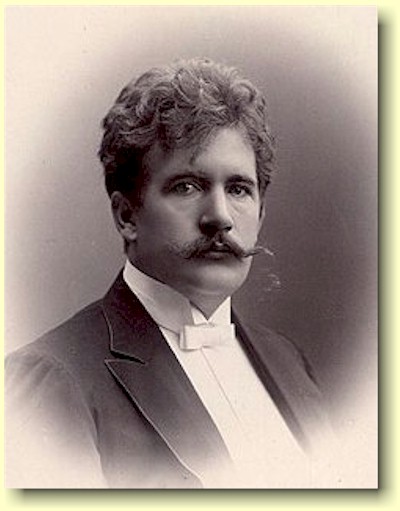
Johan Halvorsen 1864-1935
(Wikipedia)
|
|
| |
|
|
| |
|
|
| |
It is
evident that we have many folk music
versions associated with The Scottish March
Ola
Grøsland has collected some of these: |

Ola Grøsland |
|
| |
|
|
|
| |
Knut Kjøk |
Goroleikjinn after
Erling
Kjøk/ Ola Nystugun (CD)
|
|
| |
|
|
|
| |
Amund Bjørgen |
Pillarguri-slått
after Ola
Moløkken (Kappleik recording)
|
|
| |
|
|
|
|
|
|
|
| |
Jakob Skogum |
Pillarguri-slått
after Per
Bræmden (CD)
|
Nina
Owren Furuli |
Pilllarguri halling
(from her
examination concert at the Ole Bull Academy at Voss in
2004).
|
|
| |
|
|
|
|
|
|
|
| |
Lom Spelmannslag |
Sinclair halling in
the arrangement by Ola Eide (CD). This was one of
two slåtter which were used
during the opening ceremony of the Winter Olympic Games
at Lillehammer in 1994. 50 folk musicians from the whole
valley performed with play-back.
|
Ola Eide |
Pillarguri (old NRK
recording). |
|
| |
|
|
|
|
|
| |
Magnus
Holshagen |
Melody used for
the Sinclair folk song by Edvard Storm.
|
|
| |
|
|
|
|
|
| |
Hilmar
Aleksandersen |
Pillar-Guri (CD). |
|
| |
|
|
|
|
|
|
|
| |
|
|
|
| |
|
|
| |
|
|
| |
|
|
| |
George
Russell - "Trip
to Prillarguri"
Trip to Prillarguri is a live album by
George Russell originally recorded in 1970 and
subsequently released on the Italian Soul Note label in
1982, featuring a performance by Russell with Stanton
Davis, Jan Garbarek, Terje Rypdal, Arild Andersen, and
Jon Christensen. The Allmusic review awarded the album 3
stars.
(Wikipedia) |
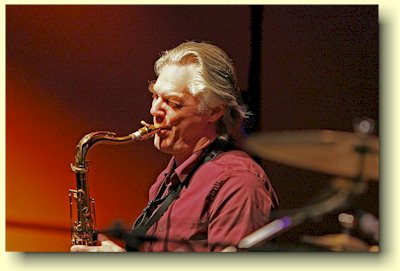
Jan Garbarek
(Wikipedia) |
|
| |
|
|
| |
|
|
|
| |
|
|
| |
|
|
| |
Týr
- a folk
metal band from the
Faroe Islands.
Their subject matter revolves almost entirely around old
Nordic lore, mythology, and history, taking their name
from a
Norse god of war.
(Wikipedia) |

Týr
(Wikipedia)
|
|
| |
Track listing (from
Wikipedia)
| # |
Title |
Words |
Music |
Length |
| 1 |
Gandkvæði Tróndar |
J.H.O. Djurhuus (1881–1948) |
Traditional Faeroese, arr. Heri Joensen |
4:10 |
| 2 |
Sinklars Vísa |
Edvard Storm |
Traditional Danish, Heri Joensen |
4:54 |
| 3 |
Ocean |
Heri Joensen |
Heri Joensen, Traditional Faeroese |
10:07 |
| 4 |
Gátu Ríma |
Traditional Faeroese |
Traditional Faeroese, Heri Joensen |
5:38 |
| 5 |
Brennivín |
Heri Joensen, Björn S. Blöndal
(1893–1980) |
Heri Joensen, Traditional Icelandic |
4:58 |
| 6 |
Fípan Fagra |
Traditional Faeroese |
Traditional Faeroese, Heri Joensen |
5:49 |
| 7 |
Valkyrjan |
Heri Joensen |
Heri Joensen,
Traditional Faeroese,
Edvard Grieg,
Traditional Norwegian |
5:05 |
| 8 |
Lokka Táttur |
Traditional Faeroese |
Traditional Faeroese, Swedish, Heri
Joensen |
6:04 |
| 9 |
Land |
Heri Joensen, J.H.O. Djurhuus
(1881–1948), Hávamál |
Heri Joensen, Traditional Faeroese |
16:17 |
|
10 |
Hail to the Hammer |
Heri Joensen |
Heri Joensen, Traditional Faeroese |
5:19 |
|
|
| |
|
|
|
| |
|
|
| |
| |
|
|
| |
Miscellaneous |
|
|
| |
|
|
| |
|
|
|
| |
|
|
| |
Cloth
badges |
|
|
| |
Det ble
laget merker med motiv fra Kringen til å sy på jakker,
anorakker og lignende. Populært i 1950- og 60-årene.
Rød, hvit og blå bord (flaggfargene) rundt motivet.
Badges were
made featuring designs from Kringen, bordered by red,
white and blue (the flag colours). These were popular in
the 1950s and 60s and were sewn on to jackets, anoraks,
etc.
Source |
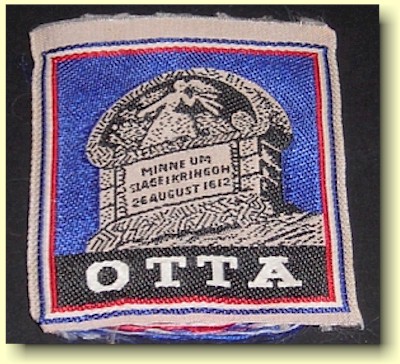
Thanks go to
Rondane
Brukt og Antikk for the
loan of the photograph |
|
| |
|
|
| |
Illustrated strips |
|
|
| |
|
|
|
| |
Vangsgutane
What
happened at Kringen was used in one of the booklets in
the illustrated series “Vangsgutane”.
Leif Halse from
North Møre wrote the text and Jens R. Nilssen was the
illustrator.
Publisher: Fonna Forlag (http://www.fonna.no
)
|
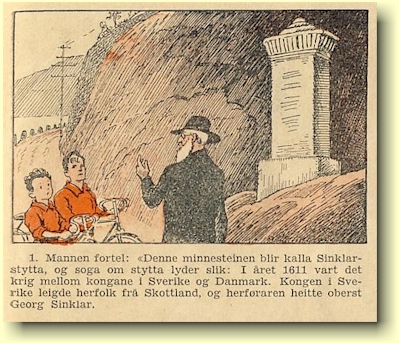
Thanks go to
Steinar Halse og Arthur Mo for the
loan of the photograph |
|
| |
|
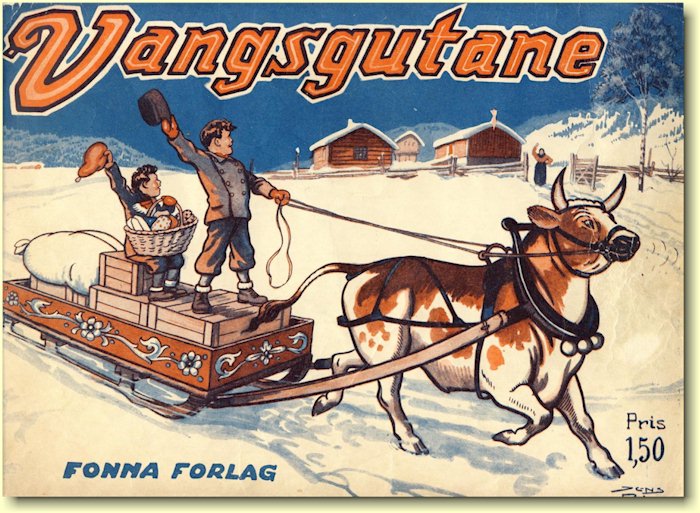
Thanks go to
Steinar Halse og Arthur Mo for the
loan of the photograph |
| |
|
|
|
| |
|
|
| |
Wooden
figure |
|
|
| |
Pillarguri - made by
Henning Norsk
Treskjæring.
Thanks go to
Henning and Bjarne Espedal for the loan of the
photograph.
HENNING
is a Norwegian woodcarving company run by the Engelsen
family.
The
woodcarver Bjarne Espedal has been working at HENNINGs
since 1980. Originally educated as a MA in Physics, he
was passed the craft from his father-in-law, Henning
Engelsen (1918-2005).
Gift
figures are also sold by “Scandinavian South - America’s
largest and most complete Scandinavian Gift Shop in the
South”.
Source
HENNING WOOD CARVINGS |
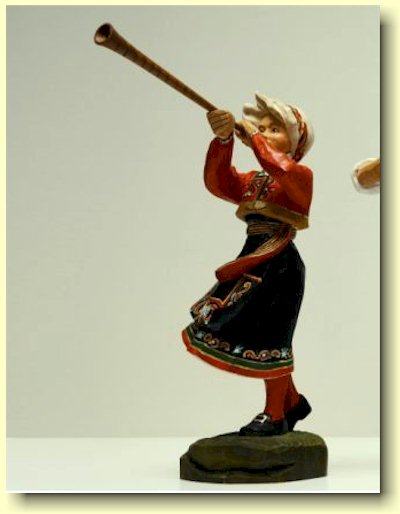 |
|
| |
|
|
|
| |
|
|
| |
|
|
| |
Pillarguri bicycle |
|
| |
Thanks go to
Magne Teigen for the loan of the photograph.
Magne Teigen is one of the driving forces behind
"Sjoa og Heidal Gammeltekniske Forening"
and has a large archive of photographs together with a
considerable store of information connected to items
this society has collected and preserved.
|
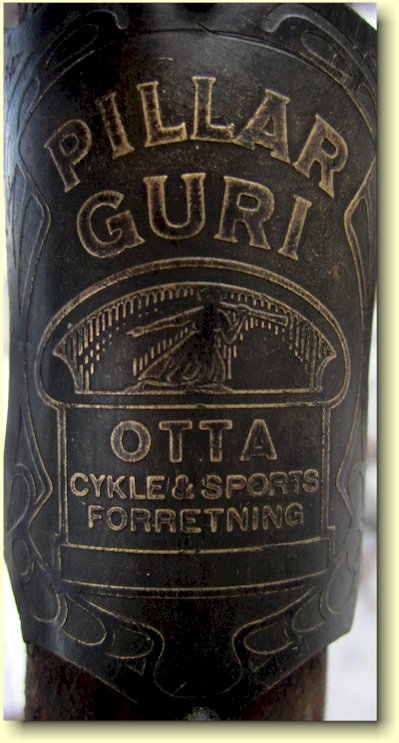 |
|
| |
|
|
|
| |
|
|
| |
Pillarguri Ovnsfabrikk (Stove Factory)
|
|
| |
I august
1927 fikk Pillarguri Ovnsfabrikk ved Ola Haugaløkken
bronsemedalje ved Lillehammer
byjubileumsutstilling "for elektrisk takke for
flatbrødbakning, elektrisk Pillarguriovn, kombinert
kokeovn for ved og elektrisk fyring."
Ved samme
utstilling fikk de sølvmedalje for en
kombinert kamin for ved og elektrisk
fyring
Ola
Haugaløkken hadde lært å lese av sin mor – før han
begynte på skolen og han ble derfor benyttet som
’hjelpelærer’ i lesing for andre barn, forteller Ole A.
Torgersrud i minneordet om ham.
Regning derimot fikk han lære lite av – på skolen var
det bare en eneste regnebok den tiden (1880-åra) – og
den var det bare gardmannsbarn som fikk bruke. Han lærte
seg derfor regning seinere.
Han arbeidde på Dale, Ottbragden, flere år i Skåbu og på
Sør-Fron. Han var også på Aulestad i Gausdal og på
dampsaga på Lillehammer. I 1907 arbeidde han på
jernbanen i Hallingdal.
Om sommeren var det ofte nybrottsarbeid (åkerland) og om
vinteren tømmerhogging.
1905 kjøpte han Haugalykkja, brøt 15 mål ny jord, bygde
nye hus og ei lita seter ved Thokampen.
Mye av tida drev han likevel med kleberarbeid.
Han laget
som nevnt også vedovner og elektriske kleberovner. |
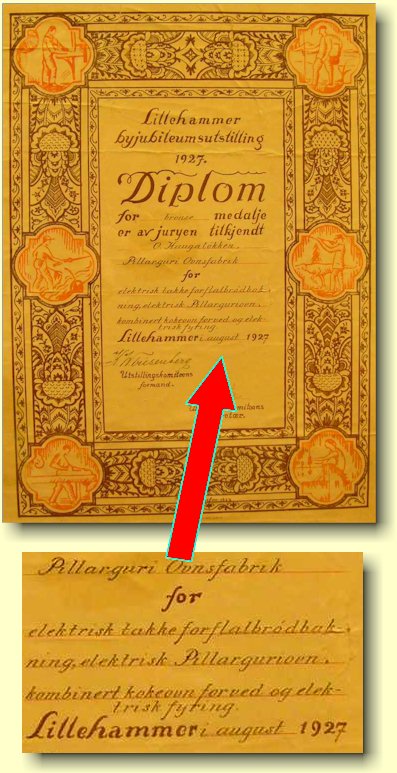 |
|
| |
Kleberovner leverte han bl.a. til Sigrid Undset, Olav
Aukrust og Inge Krokann
”Eg har da gjort litt for diktarane , eg og”
humra han. |
|
| |
|
|
|
| |
|
|
| |
Vertshuset Sinclair, Kvam |
|
| |
|
|
|
| |
|
|
|
| |
|
|
| |
Pillarguri Café, Otta |
|
| |
|
|
|
| |
|
|
|
| |
|
|
| |
Pillarguri
Skifer
(Pillarguri Slate) |
|
| |
|
|
|
| |
|
|
|
| |
|
|
| |
Gudbrandsdalslaget i
USA (Gudbrandsdalen Society in the USA) |
|
| |
|
|
|
| |
Gudbrandsdalslaget
in the USA celebrated its 100th.
Anniversary in 2009
It was
founded in Minneapolis.
The 12th. of September 1909 is regarded as the founding
date. The Society was an amalgamation of the Fargo
Society in North Dakota and the Kringen Society in
Wisconsin with Pastor Lars P. Thorkveen as its first
President (President from 1909 until his death in 1923).
The aim
of the Society should be to maintain the bonds with
Norway and be somewhere that immigrants from Norway,
particularly those from Gudbrandsdalen, could meet.
The
100th. Anniversary was celebrated between the 5th. -
8th. August in St. Paul. Read more about the programme
here.
The
President Jim Olsen, together with a group from the
Society, paid a relatively long visit to Gudbrandsdalen
in 2009.
The
Society is planning a visit to Kringen and Norway in
connection with the 400th. Anniversary in 2012.
In this respect Jim Olsen was in Otta in April 2010 and
May 2011 and received information about the arrangements
for the coming occasion. |
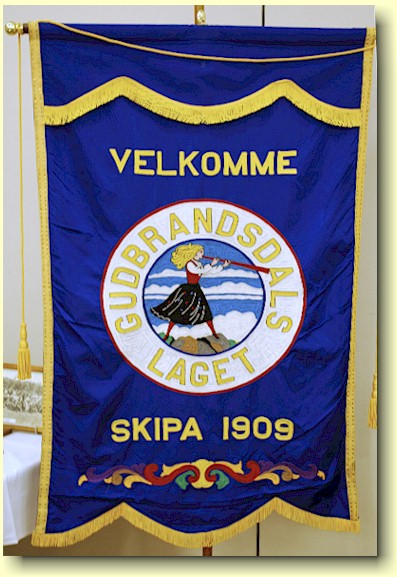
USA - Gudbrandsdalen Society’s banner from 1969
- with Pillarguri as the central design.
|
|
| |
|
|
|
| |
The Society
played an important part in the 300th. Anniversary in
1912 (see the text in the box on the right).
The leader
at that time, Lars Paalson Thorkveen, was decorated with
the Order of St. Olav by King Haakon VII, and the
Society received the Norwegian flag from 14 districts in
Gudbrandsdalen |
Close ties
to Gudbrandsdalen - Kristen Holbø’s Pillarguri
Monument at Kringen in Sel.
Pastor
Lars Paalson Thorkveen
was, as has
already been said, the first President - and one
of the first tasks was to collect 200 dollars
for the erection of the Pillarguri Monument at
Kringen in Sel.
(A
considerablei sum of money one hundred years
ago. At that time the monument cost 2250,-
kroner, plus 400,- kroner in payment to the
sculptor Kristen Holbø, according to Ola
Tamburstuen).
Three
years later Thorkveen travelled
to Norway to attend the unveiling of the
Monument by King Haakon VII at Kringen in 1912.
|
|
| |
|
|
|
| |
|
|
| |
Pillarguri -
Coat of Arms of Sel kommune |
|
| |
|
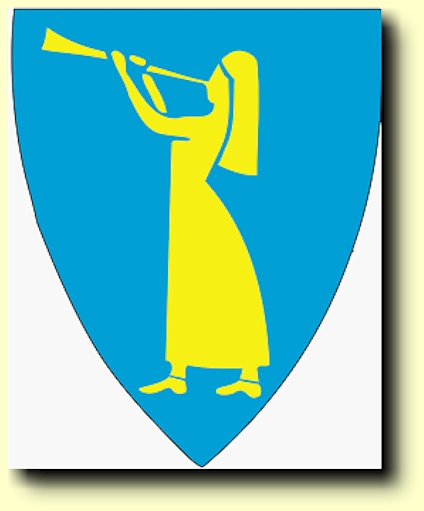 |
|
| |
|
|
|
| |
|
|
| |
Pillarguri-days in Sel kommune |
|
| |
|
|
|
| |
Pillarguridagene
arrangeres hvert år rundt den 26. august, datoen for
slaget i Kringom i 1612
Prisvinnere:
2011
Hege Schøyen
2010
Tora Berger
2009
Wenche Myhre
2008
Kristin Krohn Devold
2007
Mari Maurstad
2006
Liv Signe Navarsete
2005
Marit Breivik
2004
Shabana Rehman
2003
Kari Traa
2002
Mari Boine
2001
Trine Hattestad
2000
Anne-Cath. Vestly
1999
Åse Kleveland
1998
Wenche Foss
1997
Annbjørg Lien
1996
Rosemarie Køhn
|
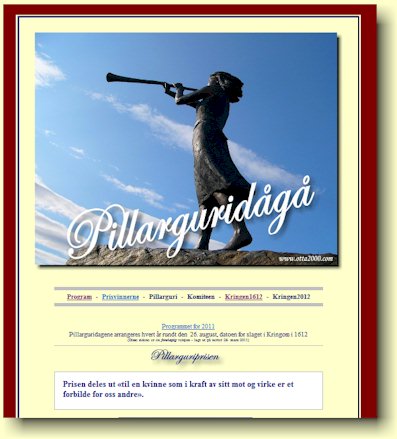 |
|
| |
Prisen
deles ut «til en kvinne som i kraft av sitt mot
og virke er et forbilde for oss andre».
|
|
| |
|
|
|
| |
|
|
|
| |
|
|
| |
Pillarguri Badmintonklubb |
|
| |
|
|
|
| |
|
|
|
| |
|
|
| |
Lodge
Kringen |
|
| |
|
|
|
| |
|
|
|
| |
|
|
| |
|
|
| |
Lodge
Sinklarstøtten |
|
| |
|
|
|
| |
|
|
|
| |
|
|
| |
|
|
| |
|
|
| |
|
|
|
Background - The
Battle - Myths?
- Significance - Objects - Literature - Scotland
-
Programme2012 |
| |
|
|
| |
|
|
| |
Updated:
23. juni 2013 |
|
| |
Web:
Geir Neverdal (lektor/cand.philol) - Sel Historielag
www.otta2000.com
|
|
| |
|
|
|
|
|
|
|
|
|
| |
|
|
|
|
|
|
|
|
|
| |
|
|
|
|
|
|
|
|
|












































